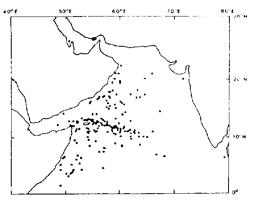 |
Science Frontiers ONLINE No. 86: Mar-Apr 1993 |
|
|
The milky sea a.k.a. "white water"
June 1854. South of Java. Aboard the American clipper Shooting Star. Captain Kingman reporting:
"The whole appearance of the ocean was like a plain covered with snow. There was scarce a cloud in the heavens, yet the sky...appeared as black as if a storm was raging. The scene was one of awful grandeur; the sea having turned to phosphorus, and the heavens being hung in blackness, and the stars going out, seemed to indicate that all nature was preparing for that last grand conflagration which we are taught to believe is to annihilate this material world."
We selected this account of the milky sea phenomenon because of its vivid verbiage -- something absent from the modern reports:
"August 13, 1986. Northwest Indian Ocean. The entire sea surface took on an intense white glow which was not unlike viewing the negative of a photograph."
 |
Geographical plotting of the reports shows a strong concentration in the northwest Indian Ocean (see figure). Seasonally, there is a strong peaking in August and a secondary blip in January. The phenomenon is independent of water depth and distance from land.
Surely bioluminescent organisms must be the explanation for milky seas. But most such organisms simply flash briefly and are incapable of generating the strong, steady glow of the milky sea. Marine bacteria alone glow steadily. However, calculations show that unrealistic concentrations of bacteria would be needed to generate the observed light. Furthermore, samples from the affected waters show no such bacteria. Herring and Watson admit there is no acceptable explanation of the milky sea. What, they ask, is so special about the northwest Indian Ocean? Why do milky seas not occur in the adjacent Red Sea and Persian Gulf? These bodies of water seem equally promising.
(Herring, P.J., and Watson, M.; "Milky Seas: A Bioluminescent Puzzle," Marine Observer, 63:22, 1993.)